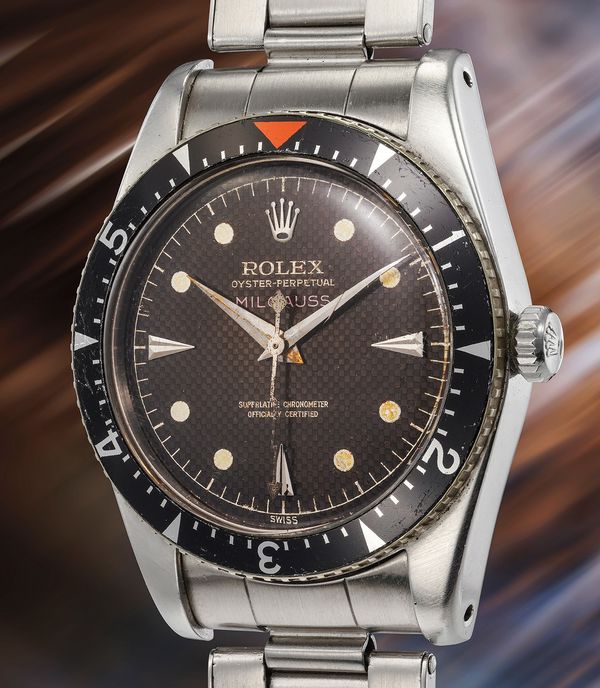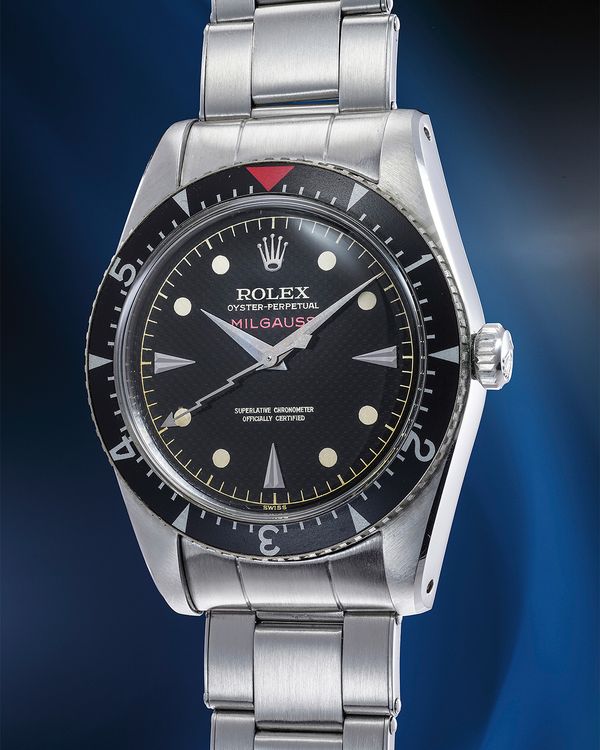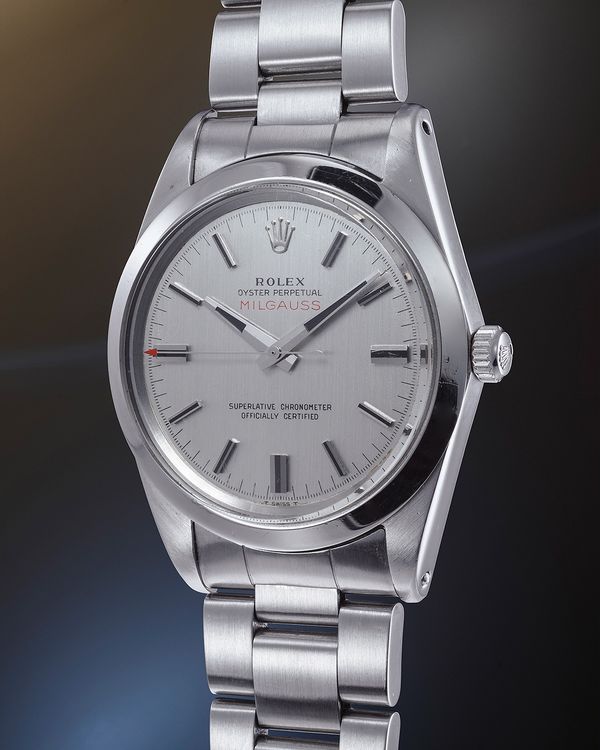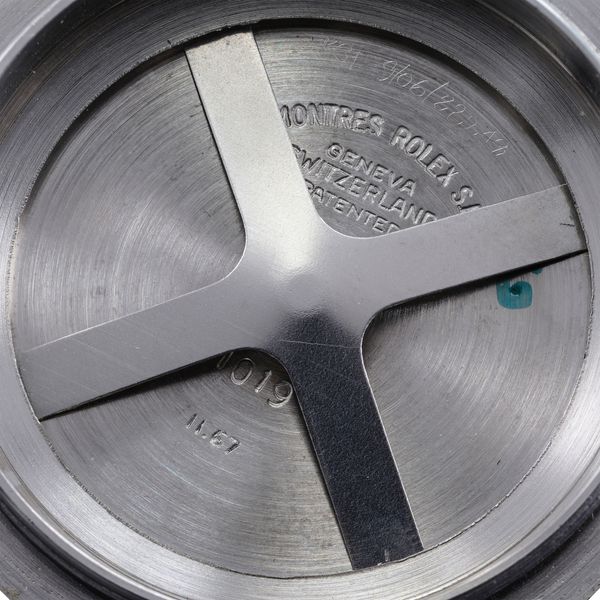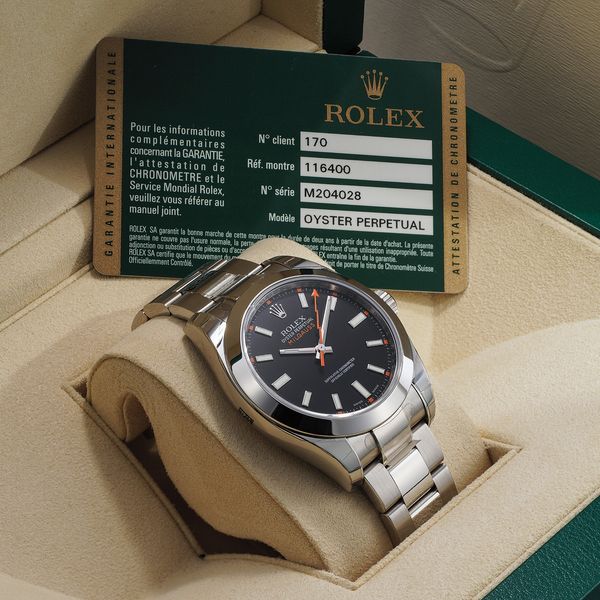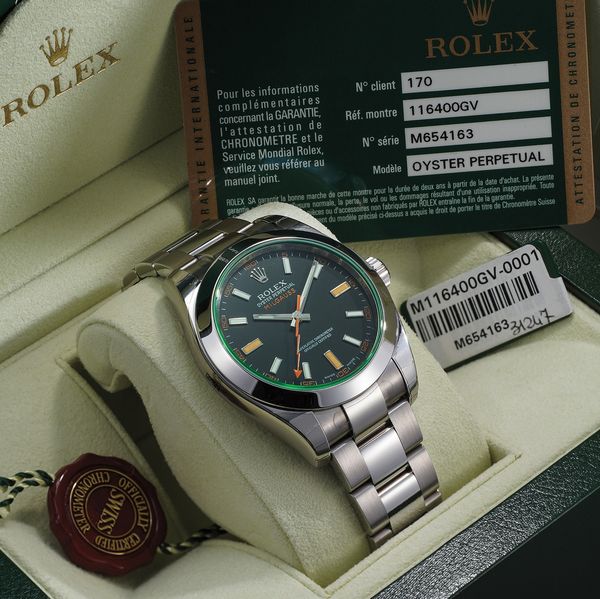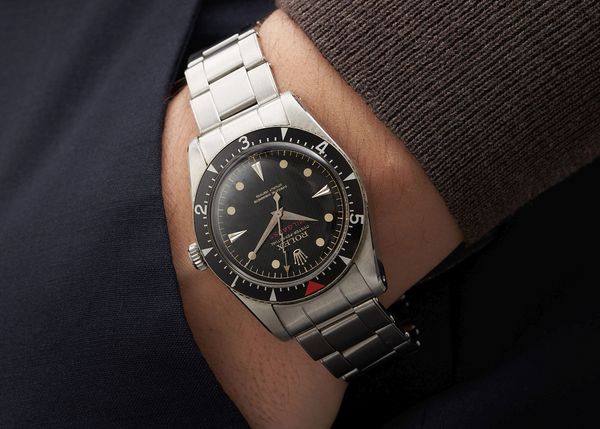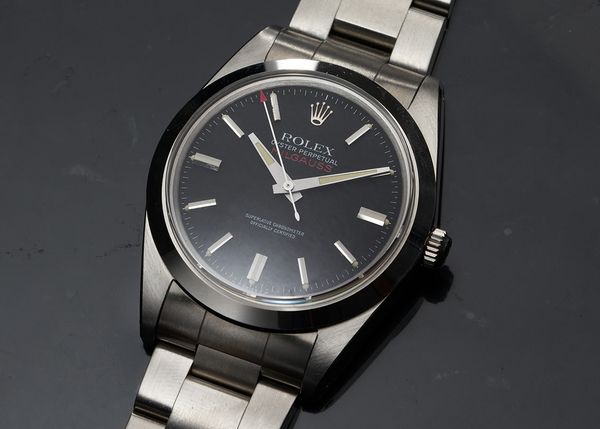Our first live auction of 2024, the PHILLIPS Geneva Watch Auction: XIX, takes place on May 11 and 12, at the Hotel President, at Quai Wilson 47 in central Geneva. The auction includes more than 215 of the world's finest watches – and though we are loath to boast, we truly think it's one of the best catalogs we've ever put together. We'll be highlighting a number of the most interesting lots and stories featured in the sale over the next month, including the Patek Philippe ref. 3670 and ref. 5950 featured in this article the vintage Rolex Milgauss ref. 6541 – and two contemporary Rolex Milgauss watches (here and here) – featured in this article.
– By Logan Baker
The Milgauss has always been the odd watch out at Rolex.
In a catalog of professional-grade sport and tool watches, the Milgauss was made for scientists working inside a laboratory. And when the original Milgauss reference didn’t sell very well, Rolex handed them out to the winning drivers of certain NASCAR races to clear stock.
More recently, Rolex has used the Milgauss as its primary platform for aesthetic experimentation – using high-contrast dials and colored sapphire crystals to attract a different audience. (Can you imagine a Submariner with a green-tinted crystal? I think not.)
None of those tactics worked quite as well as Rolex likely hoped, leaving the Milgauss a reference on the fringe until earlier this year, when Rolex unceremoniously discontinued the Milgauss family in its entirety at Watches & Wonders 2023.
This likely isn’t the end of the Milgauss’ story for good. Rolex discontinued the collection once before, in 1988, after 32 years of continuous production, before reviving it in 2007. Only 16 years later, and it’s gone again, lasting exactly half as long as its original run from 1956 to 1988.
But what exactly does that mean for the Milgauss in terms of its contemporary collectability? How might interest in the Milgauss’ various references develop now that it’s absent from the catalog for the foreseeable future?
Here’s what you should know about the Milgauss’ past, its present, and what might be in store down the road for Rolex’s “Scientists’ watch.”
In The Beginning
Many of Rolex’s best-known and most popular watches were developed alongside real-world professional organizations and companies, such as the original Rolex GMT-Master with Pan American Airways. The Milgauss has a similar background.
History says that Rolex was approached in the early 1950s by scientists at Geneva’s Conseil Européen pour la Recherche Nucléaire, better known as CERN (home to the Large Hadron Collider), who requested a new type of wristwatch that could maintain its precision in the presence of potent magnetic fields.
Rolex was happy to oblige, introducing the original Milgauss ref. 6543, in 1956. The novel antimagnetic wristwatch incorporated an interior soft iron cage surrounding the movement, protecting it from magnetic exposure up to 1,000 gauss – or mille gauss. (Some consider the ref. 6543 to be a prototype version of the Milgauss.)
It’s worth noting that around the same time Rolex introduced the Milgauss, a number of other watches with antimagnetic capabilities were also coming to market, including the Universal Genève Polerouter (1954), the IWC Ingenieur (1955), the Omega Railmaster (1957), and the Eberhard Scientigraf (1961).
With its stainless steel 38mm case and automatic movement, the early Milgauss had the same general look and feel as one of Rolex’s existing tool watches – particularly the Submariner – but it had some unusually bold elements, including a two-layer laminated aluminum dial with a honeycomb pattern, faceted triangular hour markers on the dial at three, six, and nine o’clock, and a black aluminum rotating bezel insert split into six two-part segments. It’s not fully understood today what those segments were intended to indicate, but it’s clearly related to the tracking of some sort of elapsed time interval.
The ref. 6543 was quickly updated to the ref. 6541 one year later, in 1957, with the addition of a unique central seconds hand in the shape of a lightning bolt and a few minor external updates to the lug width and the caseback. The ref. 6541 was produced in at least two different case variations – there was the standard version, with the same external rotating bezel found on the ref. 6543, and then there was a version believed to have been created for the American market, with a smooth polished steel bezel. There were also luminous and non-luminous dials offered; the latter is known as a “CERN” dial, as it’s believed these dials were custom ordered by scientists without radium in order to be used around machinery sensitive to radioactivity.
It’s believed that less than 200 total examples were created – combined – for these first two Milgauss references over a four-year period that concluded in 1960, which makes both models some of the rarest series-produced references ever released by Rolex.
These early Milgauss examples, as you might have guessed, didn’t sell very well outside of CERN. It’s believed that the smooth-bezel ref. 6541, for example, was the result of Rolex’s attempt to sell off their remaining stock after the initial rotating bezel versions failed to perform at market. The ref. 6541 was also frequently given away to the winners of certain NASCAR races until the mid-1960s.
There are archival images of drivers Pedro Rodriguez, Lloyd Ruby, and Ken Miles receiving Milgauss ref. 6541 examples after winning the Daytona Continental race in 1963 (Rodriguez) and 1965 (Ruby; Miles). A number of other former NASCAR drivers, including Richard Petty, Bobby Allison, and Edward "Fireball" Roberts, are also known as one-time owners of the Milgauss ref. 6541; the latter was even pictured wearing the watch in an early 1960s Rolex print advertisement. All the drivers received and/or owned smooth-bezel versions of the watch.
The Milgauss ref. 6543 and 6541 are both extremely rare watches, with a very small number of examples coming up in any given year. That said, the watches have maintained a consistent value in the six-figure-and-above range since the 2000s. You can even find auction records of certain ref. 6541 examples selling for close to CHF 200,000 all the way back in 2006.
In May 2023, we offered one of the best-preserved examples of the ref. 6541 to come to market, where it then set an auctio world record for highest price, achieving a remarkable sum of CHF 2,238,000. One year later, in May 2024, during the upcoming Geneva Watch Auction: XIX, we're proud to offer another amazing Milgauss ref. 6541 example (lot 142, Estimate: CHF 100,000 - 200,000). The current example, with caseback stamped IV.1958 indicating it was produced in the fourth quarter of 1958, is one of the earliest examples reference 6541 produced and presents a compendium of traits which will delight the collector.
Any 6541’s dial - with its surprising honeycomb texture - is fascinating, but the present example well exceeds expectations. Not only it is perfectly preserved without marks or scratches to the surface, but it furthermore achieved an outstanding dark chocolate tropicalisation. Furthermore, even the few ultra-small oxidation dots that occurred over the years have somehow tropicalised and, instead of being dark as it usually happen, they sport a metallic coppery finish granting the dial, when viewed under the loupe, a hardly ever seen “copper stardust” effect.
Its case number 412’424 is consistent with other examples of the reference, as most appear to bear a 412’xxx serial number. An additional intriguing detail of this specimen can be found behind the lugs: five service marks have been hand-engraved behind both top lugs and the bottom left lug, and all apparently done by the same watchmaker given the similarity in their code: 28060VA, 41414VA, 1805VA, 8844VA, 15651VA.
While extremely unusual to find such a mark on the outside of the case (normally, watchmakers etch the inside of the caseback - and indeed the present piece features two service marks to the back, but not sharing the same “style” of those behind the lugs), other examples of the reference are known with such peculiar engraving to the outside of their cases - see lot 112 in the Geneva Watch Auction XV in May 2022. A possible explanation could lie in the fact that such a professional timepiece might have been serviced locally at the institution where the owner worked, with the numbers to the outside coding some service (or regulation) information for quick reference.
Such a thesis is boosted by the fact that this watch is a non-luminous version of the model. Ref. 6541 is known with and - such as in this instance - without luminous hands/dial. Considered the intended operational environment of the piece (scientific laboratories and such) and the high radioactivity of radium-based luminous material of the time, it is speculated that no-lumes versions were reserved for technicians which needed no outside source of radiation during their work - such as CERN technicians.
In this weekend’s Geneva Watch Auction: XVII, Phillips is proud to offer the best-preserved example of a ref. 6541 that we’ve ever come across. It displays all its original factory finishes, from the bevels on the side of the lugs to the red-tipped bezel, and even the crisp milled edge of the caseback. The dial is so well preserved that it doesn't show any visible signs of aging, with crisp and eye-catching text and accents throughout.
The 1019 Years
The second-generation Milgauss, the ref. 1019, entered the picture in 1960, immediately following the discontinuation of the ref. 6541. It was a big departure stylistically from the original Milgauss, moving away from the bold styling cues of the rotating bezel, textured dial, and lightning-shaped seconds hand and adopting a simpler, more traditional all-around Rolex style.
The new Milgauss had a 38mm stainless steel case, with a smooth steel bezel, and clean matte dials in either black or silver with the all-capitalized Milgauss name in bright red under the Rolex wordmark at 12 o’clock. Of course, it maintained the Milgauss’ antimagnetic bona fides, carrying over the internal soft iron cage from the first-generation of the watch.
The ref. 1019 remained in production until 1988 for an impressive production run of 28 consecutive years, the longest of any reference in Milgauss history. During that time, a number of dial and hand variations were introduced, including the non-luminous “CERN” dials, always paired with the silver dial option.
Other ref. 1019 variations included changes to the hash marks on the periphery of the dials (one-half of a second, vs. one-fifth of a second), and the hands (polished and ridged, vs. flat and brushed), the hour markers, and the movement. The now-straight central seconds hand was topped by a bright red arrow in all versions of the ref. 1019; it's still the only time Rolex has used a red arrow-tipped seconds hand in its history.
Despite the changes, the ref. 1019 still wasn’t a hit among end consumers. The collection would eventually be discontinued in 1988, and although there are far more vintage ref. 1019 examples out there than ref. 6241 or 6243, it still was never produced as widely as something more popular, like a Submariner or GMT-Master.
As a result, the ref. 1019 enjoys a collectible-yet-accessible reputation among vintage Rolex lovers. A few dozen examples will typically pop up for sale during any given year, with prices on average hanging around the CHF 30,000+ range, with certain dial variants consistently performing better.
Into The 21st Century
Rolex finally revisited the Milgauss in 2007, 18 years after the ref. 1019 was discontinued and timed to the 50th anniversary of the release of the original Milgauss ref. 6541. The new-generation Milgauss ref. 116400 referenced elements of the original references while adapting them for a more modern, youthful audience.
The six-digit generation brought in a larger case diameter (40mm), a Parachrom-equipped automatic movement (caliber 3131), and enhanced resistance to magnetism over 1,000 Gauss (although Rolex has never confirmed its exact resistance rating) thanks to an updated two-piece shield construction. The bezel was once again smooth, but the lightning seconds hand had officially returned! Now in bright orange, it added a bit of levity to the otherwise serious-looking watches in Rolex’s modern catalog.
The original ref. 116400 from 2007 was offered in three dial configurations. There was a pair of standard options in black or silver, both with extensive orange accents, and then there was a special-edition black dial reference that came with a unique, green-tinted sapphire crystal over the dial. The Milgauss ref. 116400GV (GV, glace vert, or “green glass”) was a completely unexpected addition to the Milgauss family, emphasizing an entirely new design approach for Rolex. It was a different application of green for the brand, which had been recently been used in the 50th anniversary edition of the Submariner, the highly memorable “Kermit.”
Seven years later, a new version of the ref. 116400GV was introduced in 2014 by Rolex, pairing the glace vert crystal with an electric-blue dial nicknamed “Z-Blue." Rolex discontinued the non-GV Milgauss models in 2016, but the Z-Blue and black-dial GV watches remained in production all the way until Watches & Wonder 2023.
Outside the addition of the Z-Blue model, the modern Milgauss saw no other changes or variants in its 16-year lifespan. The case design, dial orientation, and movement all remained exactly the same between 2007 and 2023. By the time the ref. 116400 was discontinued, it was one of Rolex’s longest running references this century. The ref. 116400 enjoyed a bit more attention and notoriety than its predecessors, although it never saw a significant increase in secondary market valuation like the more iconic Rolex sport models did the past few years.
On a more anecdotal level, I personally know multiple individuals that own a ref. 116400 as their only watch and wear it every single day. Most of those people were all attracted to it for the same reason: its "outsider" status.
They wanted to treat themselves to their first Rolex in recognition of their life and achievements, and yet they all felt a Submariner or Daytona had some degree of cultural and/or socioeconomic baggage they weren’t comfortable with.
But a Rolex with a neon-green crystal and lightning-shaped seconds hand? That’s a Rolex they could get on board with, precisely because it didn’t fit their preconceived expectation of what a Rolex should be.
What Might Come Next
The Milgauss was surrounded by discontinuation rumors for the past few years, but 2023 was the year Rolex actually went ahead and pulled the plug completely, opting not to follow it immediately with a new generation.
Although it’s rare for Rolex to discontinue a watch collection in its entirety, it’s not unheard of. They also killed off the Cellini this year, but they did introduce a spiritual successor in the all-new Perpetual 1908 collection. If you look a bit further back in time, to the mid-2010s, you might recall Rolex discontinued the Air-King in 2014 before bringing it back two years later, in 2016. At the time, the Air-King was one of Rolex’s longest-running watch collections, but it was similar to the Milgauss in being a bit of a misfit in the greater current catalog.
Could a short goodbye followed by a refresh be Rolex’s plan for the Milgauss? It's hard to say for sure, but if so, I doubt we’ll see Rolex bring back the colored-sapphire crystal treatment. It was a design choice that was specifically of its era, and I think it would be fitting for Rolex to leave it behind. If that’s the case, I wouldn’t be surprised if the interest in and overall desirability of the two glace vert Milgauss watches increases as time goes on.
The future of the Milgauss is especially interesting because Rolex could really decide to take it in any direction; it has no specific comprehensive design history that collectors associate with it, so it’s not tied down to any single aesthetic. I think it would make sense for titanium to enter the Milgauss spectrum in some capacity. Rolex has introduced its first two series-produced titanium watches in the past year, and the lightweight material has much better antimagnetic properties than conventional stainless steel. What if Rolex made the Milgauss a titanium-only collection? Anything is possible.
It’s hard to see too much change happening in the near future regarding interest in vintage Milgauss examples. The ref. 1019 will remain an excellent entry-level option in the realm of collectible vintage Rolex professional watches, and the ref. 6541/6543 will always have interested collectors, even if it exists in a more rarefied air. I do think it would require the introduction of an entirely new Milgauss family to significantly change the amount of attention surrounding these early Milgauss references – but time will tell.
Rolex tends to approach its future in terms of decades rather than fiscal quarters or individual years, and I think that’s the most appropiate approach to take when we think about the Milgauss more broadly.
Even if it's struggled a bit to find its footing throughout its history, that isn’t a death sentence or something that will remain true forever. It’s possible Rolex could introduce a new version of the Milgauss next year that changes everything and makes it the most popular watch in the world.
Will that happen? Probably not, but you never know – the legacy of the Rolex Milgauss is still being written.
You can learn more about the Rolex Milgauss and register to bid on the highlighted pieces above by visiting the online catalog for PHILLIPS Geneva Watch Auction: XVII.
About Phillips In Association With Bacs & Russo
The team of specialists at PHILLIPS Watches is dedicated to an uncompromised approach to quality, transparency, and client service. Phillips in Association with Bacs & Russo holds the world record for the most successful watch auction, with its Geneva Watch Auction: XIV having realized $74.5 million in 2021. Over the course of 2021 and 2022, the company sold 100% of the watches offered, a first in the industry, resulting in the highest annual total in history across all the auction houses at $227 million.
About Logan Baker
Logan has spent the past decade working in watch-focused media, reporting on every aspect of the industry. He joined Phillips in Association with Bacs & Russo at the start of 2023 as the department's Senior Editorial Manager. He splits his time between New York and Geneva.
Recommended Reading
Discovering A Rolex Submariner Ref. 6200 With 'Explorer' Dial
Two Very Different Rolex Ref, 6062 Watches United At Last
Aurel Bacs: This Is What Happens When You Love Billiards, Rolex, And Paul Newman


